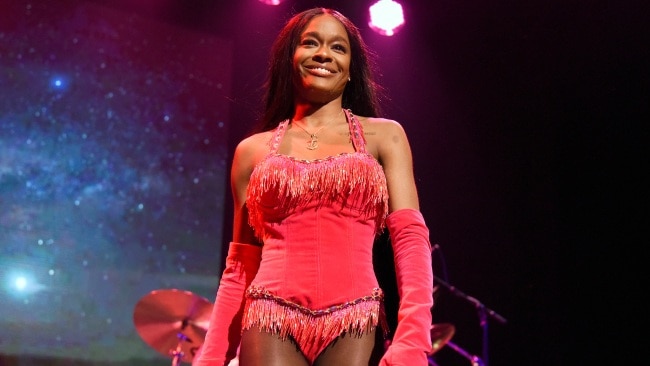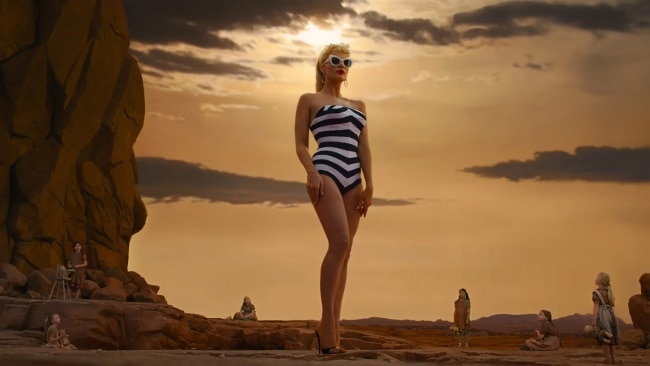Extreme tension at this 'unmissable' exhibition
The Archibald Prize is travelling the country. Do you think the nation's biggest art prize should celebrate the best work, or should they seek to ingratiate conversation-starters?

The Archibald Prize is travelling the country. Do you think the nation's biggest art prize should celebrate the best work, or should they seek to ingratiate conversation-starters?
The 101-year-old Archibald Prize, an Australian institution steeped in colonial history and prestige, is making an effort to get with the times.
This year, the Art Gallery of New South Wales’ trustees — the prize’s annual judges — awarded the honour to Dhungatti artist Blak Douglas for Moby Dickens, a striking portrait of esteemed First Nations artist Karla Dickens, knee-deep in the tragic, muddy scenes of the Lismore floods. The win was symbolic; in the face of political sluggishness, Douglas’ signature graphic style and ominous colour palette gave flood victims a much-needed voice. It also made him the second Indigenous artist to win the Archibald, following Vincent Namatjira’s historical victory in 2020.

For some critics, all this progress proved too much to handle. The Archibald should acknowledge the most technically skilled painter, they argue, not the most woke.
Way back in 1921, the Archibald was established at the bequest of political magazine publisher JF Archibald, to ‘amplify portraiture art, support Australian artists and memorialise the country’s greatest figures’.
Today, these founding principles still underpin the prize. But our understanding of what makes a ‘great’ Australian figure has changed a lot a century. It’s only natural that our culture’s shifting values would be reflected in the 52 Archibald finalists and the faces they choose to commemorate.
This year, one of the most talked-about works — among younger viewers especially — was first-time finalist Daniel Boyd’s Untitled (AAO). Boyd chose to paint controversial Western Sydney drill-rap group OneFour using his signature pointillist dot fields, claiming he was drawn to their distinctive sound and ‘ungovernable’ energy.

The group’s potent lyricism is inspired by its members’ quest for survival against the backdrop of crime and violence that filters through their hometown of Sydney's Mount Druitt. OneFour was forced to cancel their national tour in 2019 following police pressure on venues, and one of their rappers, Salec Sua, was jailed after pleading guilty to reckless bodily harm in company. Their raps, which address issues like racism, identity and marginalisation, have struck a chord with listeners all over the world.
Boyd sees the group as a product of our country’s social inequalities, which are fuelled by racism, classism and imbalanced censorship. By choosing to memorialise their divisive nature, Boyd is radically intervening in the elitist legacy of the Archibald. In doing so, he renders those communities most under-represented in the gallery space more visible, utilising his obscured and anonymising style to trigger an important conversation around the ironies of truth-telling in Australia.
To those not familiar with Boyd’s distinctive style, the painting could appear slightly nebulous, especially next to finalists with a more photoreal appeal. But the perforated effect of Boyd’s painting is incredibly challenging to execute, as he’s relying on colour, light and shade instead of distinct shapes to render his subjects visible.
Another example of a changing face of ‘great’ Australian figures is captured in Mostafa Azmitibar’s KNS088 (self-portrait). The portrait seeks to capture nine years lived in Australian detention camps, first on Manus Island and then a Melbourne hotel.

Fleeing his worn-torn homeland as a Kurdish-Iranian refugee, Azmitibar captures his outward expression in a sea of muted, dripping colours, confronting audiences with the traumas inflicted by Australia’s asylum policies.
The technical choices in Azmitibar’s portrait would usually be considered inadequate for a finalist position in the prize, especially when compared to the high-level of skill displayed in other finalists’ works. Despite this, the artist's choice of medium, application and subject forms a powerfully charged dialogue that dominates the room.
Azmitibar used acrylic paint, coffee and a toothbrush to gesturally mark the canvas, a homage to the humble materials used when teaching himself to paint in detention. Having only gained freedom in 2021, Azmitibar is both a first-time entrant and a finalist in the Archibald. The artist says his portrait's message is one strictly of love, elaborating that “love is how we kill the monsters. We are all one family, connected by our humanity”.
Artists are also breaking with traditional portraiture through a diverse use of mediums.
Jude Rae’s The big switch - portrait of Dr Saul Griffith, is framed by a triptych of solar panels that shattered in the artist's creative process. Painted with a look of anguish on his face, Griffith is a Sydney-born inventor and engineer paving Australia’s renewable revolution by replacing combustion-run technologies with electricity.

In a year where references to climate change abounded — finalist Yvette Coppersmith’s portrait of youth climate activist Ella Simons was another crowd favourite — Rae’s portrait was highly commended.
The work’s vivid undertone grows to engulf the wire grasped by the subject, generating dramatic orange energies that intensify the matter's urgency.
The textured cracks of the panelled frames shimmer beneath the lights and may represent beacons of hope for renewable energies in the depths of Australia’s reliance on fossil fuels.
Though Rae has rendered Griffith using a technical realism style that’s common to her observational painting practice, the inverted tonal relationships that evolve within the canvas lend the subject a sense of agency that’s unmatched in other finalist portraits.
“Like this portrait, Australia’s climate policy is now going right down to the wire”, the artist says. “It is crazed and cracked but the recipe is simple — electrify everything with renewables.”
Like many good exhibitions, there is light and shade in this year’s prize. Thom Roberts’ charming portrait Rachey in the mirror brings a welcomed lightheartedness to the 2022 show.
Roberts is one of five Archibald finalists selected from Studio A, a Sydney-based arts company providing professional development for artists with intellectual disabilities. His unique perception of the world as a neurodiverse artist offers his practice a playful and grounding authenticity, captured perfectly in his portrait of Shelley Simpson, founder and director of iconic ceramics brand Mud Australia.

Painted on a Mud dinner plate, Roberts’ charming work is the only ceramic surfaced portrait to be selected as a finalist this year. The artist’s ability to translate his subject onto a small-scale surface in semi-representational artistic style is highly commendable. Though the work’s technical skills may not distinguish Robert’s portrait from the rest of the group, its experimental and spontaneous nature surpasses the spirit of all finalists this year.
Next to such politically, socially, and culturally engaged works, portraits that are beautiful for purely aesthetic reasons risk taking a backseat.
Fiona Lowry’s portrait of architect Glenn Murcutt is painted in the artist's signature airbrushed style to encompass the subject in a haze of soft ambiguity, yet his resonance feels confined to a certain demographic of viewers - those who are not looking for a cultural critique, and who instead are here to adore technical talent.
Hong Fu’s painting of Peter Wegner, who won last year’s Archibald Prize, also ripples with precision and poise.

It's clear that this year, the Archibald jury was torn between upholding traditional artistic brilliance and acknowledging works with the ability to spark social change.
This tension does not come at the cost of the exhibition's cohesion. The contrast between the formative and traditional styles on show, as well as the diversity of sitters, lends the prize a unique sense of tension between old and new. And that strain is exactly what makes it a viewing experience that's not to be missed.
If the Archibald — and portraiture as a medium — is to maintain its relevance in the present, the idea of what makes a ‘great, influential’ figure, is one that needs constant revisiting. Because an artist’s duty is to create something absorbing and convincing, something that holds an allure over its witnesses. This is why art can be, and has always been, a powerful tool for social change. And as we saw this year, social reflection and skillful portraiture don't have to be mutually exclusive.
If you're looking for an alternative view, you may enjoy this review of the exhibition by Christopher Allen, who says the art prize is a 'distasteful mess'
MORE FROM THE OZ ON ART:
The best affordable galleries to buy from
The seven young artists you can afford to invest in
You can catch the 2022 Archibald Prize as it travels around Australia to the following locations:
Bunjil Place, Melbourne, 3 September - 16 October 2022
Blue Mountains Cultural Centre, 22 October - 4 December 2022
Grafton Regional Gallery, 17 December 2022 - 29 January 2023
Wagga Wagga Art Gallery, 10 February - 26 March 2023
Museum of Art and Culture Lake Macquarie, 8 April - 21 May 2023
Western Plains Cultural Centre, 3 June - 30 July 2023.


